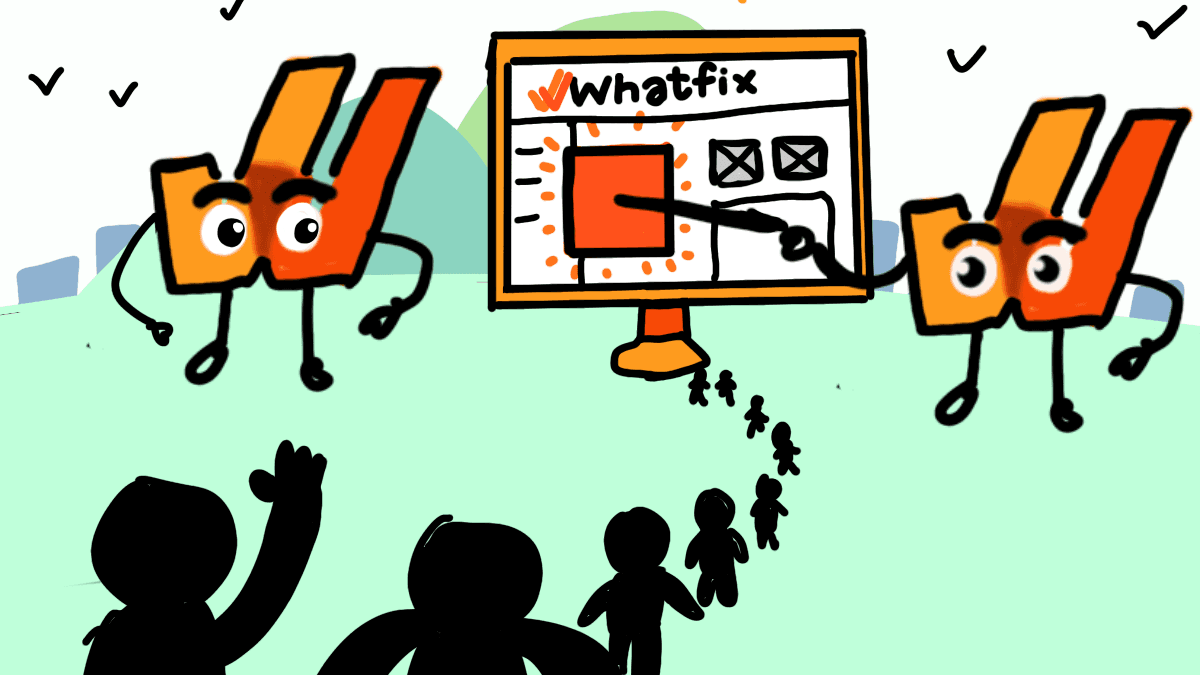
Mar 19, 2023
Can $1Bn Whatfix Fix What Breaks Global Software?
Profile
Productivity
Infrastructure
SaaS
B2B
Series B-D
Last fortnight, Whatfix posted strong revenue growth, hot on the heels of a year of consolidation and building for the global market
Dazed but Not Confused
Khadim Batti and Vara Kumar worked with cutting-edge technology and led business intelligence teams at Huawei.
With educational backgrounds in engineering, they worked day jobs like most common folks. But like many uncommon folks, they thought about building.
The beautiful thing about starting something is that unless you do, you won’t find out if you are onto something big. And if you aren’t, you can always pivot until you make it big.
Around 2011, the duo began to feel that they worked well as a team and decided to figure out marketing for small and medium businesses (SMBs) by building a ‘SearchEnabler.’
The idea was to build a ‘do-it-yourself’ style solution that would crunch data points from the web and synthesise these into actionable marketing recommendations, especially for social media.
This simplified marketing and the product hit home for many companies.
This was when social media gained traction, and their solution found many takers. Within a year, Khadim accumulated 100 customers with a small ticket size.
The ‘DIY’ approach was chosen because they targeted small businesses with a low-cost solution. They could not charge thousands of dollars in training, support and service at a ticket size of $ 20 - 30.
Khadim soon realised that customers churned out after they used the service a few times. Customers did not realize a return on their purchase and hence did not continue to implement the recommendations provided.
The solution was less self-servable than they had imagined and charging customers a hefty support fee would decrease purchases anyway.
They felt they needed to solve the usage problem to retain customers. They could either wrap things up or figure out a way to make the service fully self-serve.
By 2013, they decided to persist. In their pursuit of fixing the problem, Whatfix emerged as a by-product.
They introduced a ‘fix-it’ button in the product that showed customers exactly the parameters needed to be fixed in their product or website.
In addition to their marketing service, customers were now returning for the ‘fix-it’ solution. Customers wanted to use it for their customers as a substitute for time spent on training and support.
This made them realise that the ‘fix-it’ or support problem was perhaps more compelling than the marketing problem they set out to solve. They took the opportunity with both hands.
After a three-day brainstorming, they decided to shut down SearchEnabler and offer a painkiller solution.
The time was ripe for a pivot.
Whole Lotta Problems
In 2014, Whatfix was solving a very fundamental problem.
About 750 - 800 billion USD worth of enterprise software was sold yearly. Individual enterprises only realise a return on the hundreds of millions of software they buy if their employees utilise it efficiently.
Whatfix was essentially a guidance layer built on the existing ERP, CRM, or software stack employees use.
For employees, this would look like getting nudges and guidance through text and videos on demand and as part of their application! Customers received handholding or instructions when the information was important.
When employees use the intended software well, it better fulfils a purpose, and organisations get a better ROI. Employees also save hours reading complex manuals and training, making fewer mistakes and learning quicker and more effectively with timely and in-context help.
The application also interacted differently with new and existing users and tailored the communication to specific needs. Whatfix could also be used across various workflows and provide multilingual support.
Added to this were user-level tracking and customised reports that helped with dynamic analysis and tracking.
Whatfix began to be called a GPS for software
Experience had made Khadim realise that given the SaaS adoption and expenditure, the right market for their new guidance product was outside India. However, they didn’t take the next flight to Silicon Valley to sell.
Instead, they set out to get validation and feedback on the product from local Indian companies.
As a two-person team, they started sending customised cold emails daily to about 25 companies, mostly based out of Bangalore.
If they were lucky to get a response, they would meet the company to demonstrate their product. Over the first 30 - 40 demos, while they landed only a handful of customers, they received positive reactions and vital feedback that would shape their future product.
This was a close enough product-market fit for them to aim for the US market. They landed their first two US customers with a similar email approach followed by phone calls.
Khadim gradually refined his sales pitch based on the problem statements that the customers repeated. Initial customers were companies capable of paying $ 2,000 - 3,000 a year.
With better belief in the product and a ready sales template, they finally brought a sales team to expand the customer base. The mantra was to get feedback, fine-tune the product and scale gradually.
But, this time, the customers came back and didn’t leave.
Whatfix was ready to scale.
Software Communication Breakdown
Whatfix raised a $900k seed round in 2015 to fuel the move post the ‘SearchEnabler’ pivot.
After the initial success with the first few customers, Khadim didn’t jump to scale the solution.
After initial validation in India, they also sought to work closely with their international customers to understand challenges and determine prices. Selling to enterprises was going to be very different from selling to SMBs.
Enterprises typically spend a few million dollars on software every year. To see a good return on this investment, they were willing to write cheques of $50-100k. While the SMBs used Whatfix to solve for adoption for their customers, large enterprises used it to improve training and support for internal software.
Pricing too, was a learning journey. At one of the events, when they enquired about the price point, they mistook a monthly price of $8000 for a yearly ask.
This was also when Khadim realised that customers would pay much more for the solution.
With this pricing point and the need in enterprises, they now unearthed a total addressable market (TAM) of multiple billion dollars for Whatfix.
However, while customers showed interest, sales took work. After introducing the product, the team usually set up multiple follow-up meetings to show a proof of concept followed by a 15-day trial.
They demonstrated the use cases and ROI on software. It was a product that was more seen than heard.
Partnering with enterprises also entailed adherence to multiple compliance and security guidelines. They also found ways to make the product usable as browser extensions, modular and comply with various cloud and data privacy limitations.
With each hurdle passed, the path to more enterprise customers opened up, with Whatfix bagging its first Fortune 10 customer in a couple of years.
It would take them three years to hit the $1 million revenue mark.
The next round of funding (Series A) of $3.6M would come almost immediately in 2017. Deal sizes that had started at $50 - 80K were now growing to $500 - 800K.
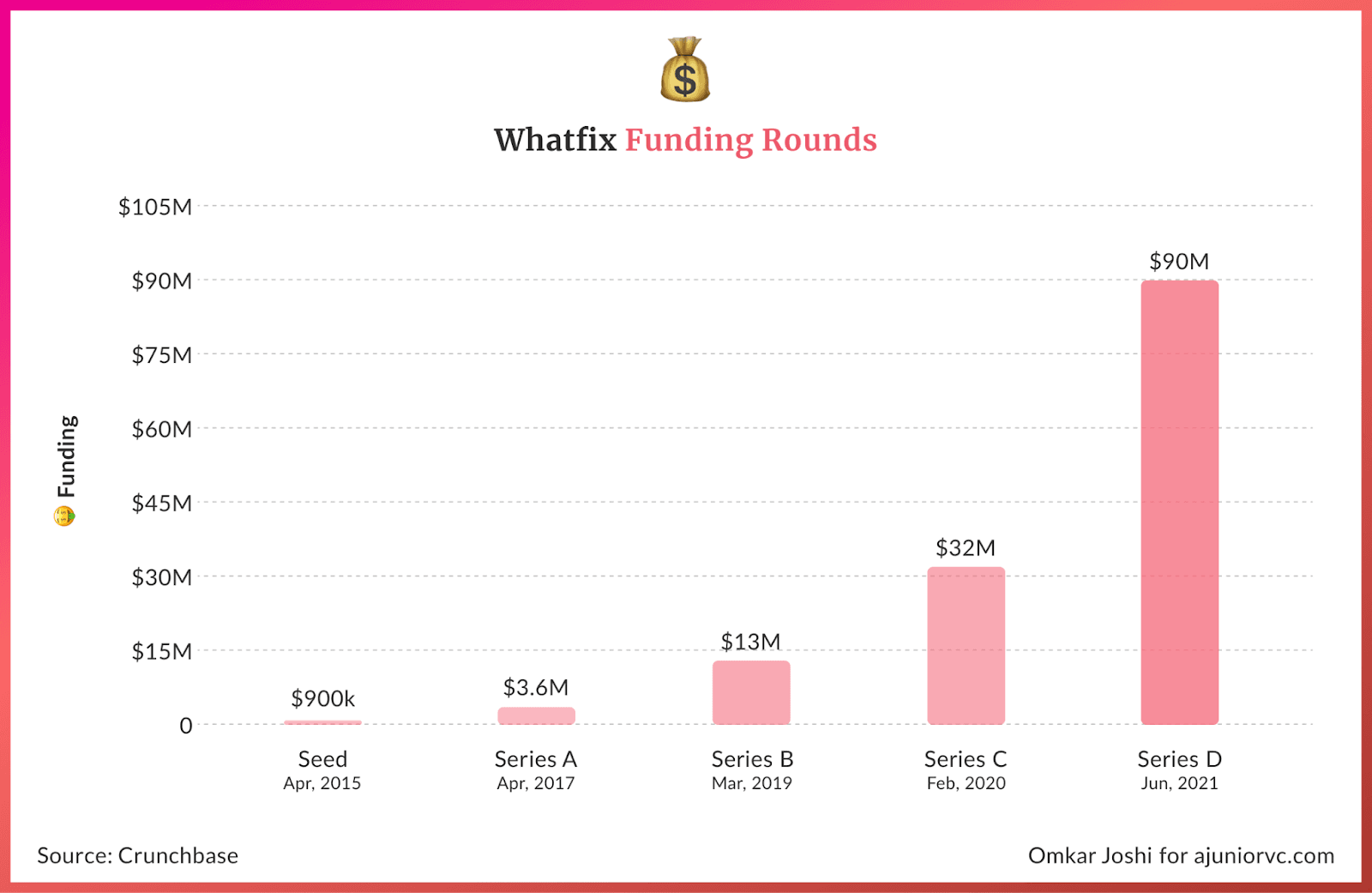
By 2018, with investor validation and a more defined product-market fit, Whatfix was beginning to take off.
When the Growth Levee Breaks
Whatfix had grown by building products and listening to customers.
They listened to customers, built a quick solution, validated early traction, and grew their offerings. This helped to develop through strong word-of-mouth publicity.
It had started as a DIY marketing tool SearchEnabler for SMBs, gaining early traction, and pivoted to build for the market.
By 2018, the first step towards growth hacking for Whatfix was creating its community. They cold-emailed SMEs to announce the Whatfix community, open to all to use and integrate.
The content was public.
The idea was to keep engaging customers in the community and on the web for 30 days until the product acquired some polish before formally rolling it out.
This led to early traction. Being a new category creator, it immensely helped the Whatfix team when one customer advocated the benefit to others and explained prospects in their language and use cases.
Strong referrals flowed in.
Whatfix soon had many Fortune 500 and Fortune 1000 customers ready to adopt this new tool, which helped onboard users onto new software and provided in-app guidance and on-demand learning.
Whatfix had the playbook for growth. It could soon develop many other products and evolve into a comprehensive digital adoption platform.
By 2019, it had reached 30 Cr of revenue, from almost zero a few years back.
As Whatfix scaled, it became more data-centric, using customer engagement data to develop a leading tracking metric to monitor customer relationships.
The product and customer success teams monitored this metric and proactively engaged with at-risk customers to improve their experience. Whatfix also used data for internal decisions on price points, investments, optimisation, and experimenting with the entire funnel.
Whatfix’s growth had it staring at a huge market
No Quarter of Slow Growth
The Global digital adoption market or DAP consists of two types of service providers- On-premises and Cloud.
The market was expected to reach USD 4Bn by 2030 at a Compound Annual Growth Rate of 16.2%.
This growth was fuelled by rapid digital transformation and the need for automation that was prevalent across companies of all sizes across all sectors.
As Whatfix and the world entered late 2019, there would be the perfect storm for the greater adoption of digital tools.
COVID became a huge enabler of the transformation to digital tools. As employees working from home, their need for collaboration and dependence on software tools increased, and DAPs became even more relevant.
Entering COVID, it had reached a healthy revenue of 60 Cr, with almost 2x growth on the previous year. It was looking at eating the on premise DAP market.
On-premises DAP software had the largest share of the global DAP software market, owing to its advantages like better security features than cloud-based DAP software.
However, as cloud-based services are more accessible, affordable and easy to set up at a fraction of the cost of on-premises services, cloud-based DAP software was expected to grow much faster over the coming years.
Whatfix was placed as one of the main beneficiaries of these tailwinds and had the potential to take the pole position.
But others would not leave it to win everything alone
Good Times Bad Times
By late 2020, Whatfix’s category saw multiple players coming, each raising giant funding.
WalkMe raised $300M+ to guarantee to enhance user experience through in-app guidance. Pendo raised a total of $450M to become a unicorn. Smaller players like UserLane, Appcues and Apty also picked up.
But the race for the top is a 3 way between WalkMe, Pendo and Whatfix.
Most of the key features of WalkMe were similar to Whatfix. For a small startup, WalkMe isn't a preferred solution since it requires a bit of technical knowledge, was priced expensively, and its customer service has a bad reputation among small-medium-sized businesses.
Whatfix solved this by simultaneously reducing content creation time, creating multi-format content, and fostering a self-serve culture.
Pendo on the other hand positioned itself as a platform with advanced analytical features and enterprise software. For product analytics and user segmentation, Pendo was a great solution. Big clients like Zendesk, BMC, and Sprinklr chose Pendo to understand and guide their users.
However, there were limited onboarding elements, and a better variety of styling options could exist. It restricts you from creating a smooth onboarding experience. Using it could sometimes be confusing since Pendo had many different features for different use cases.
The pricing of Pendo was above the market average, which put Whatfix at an advantage
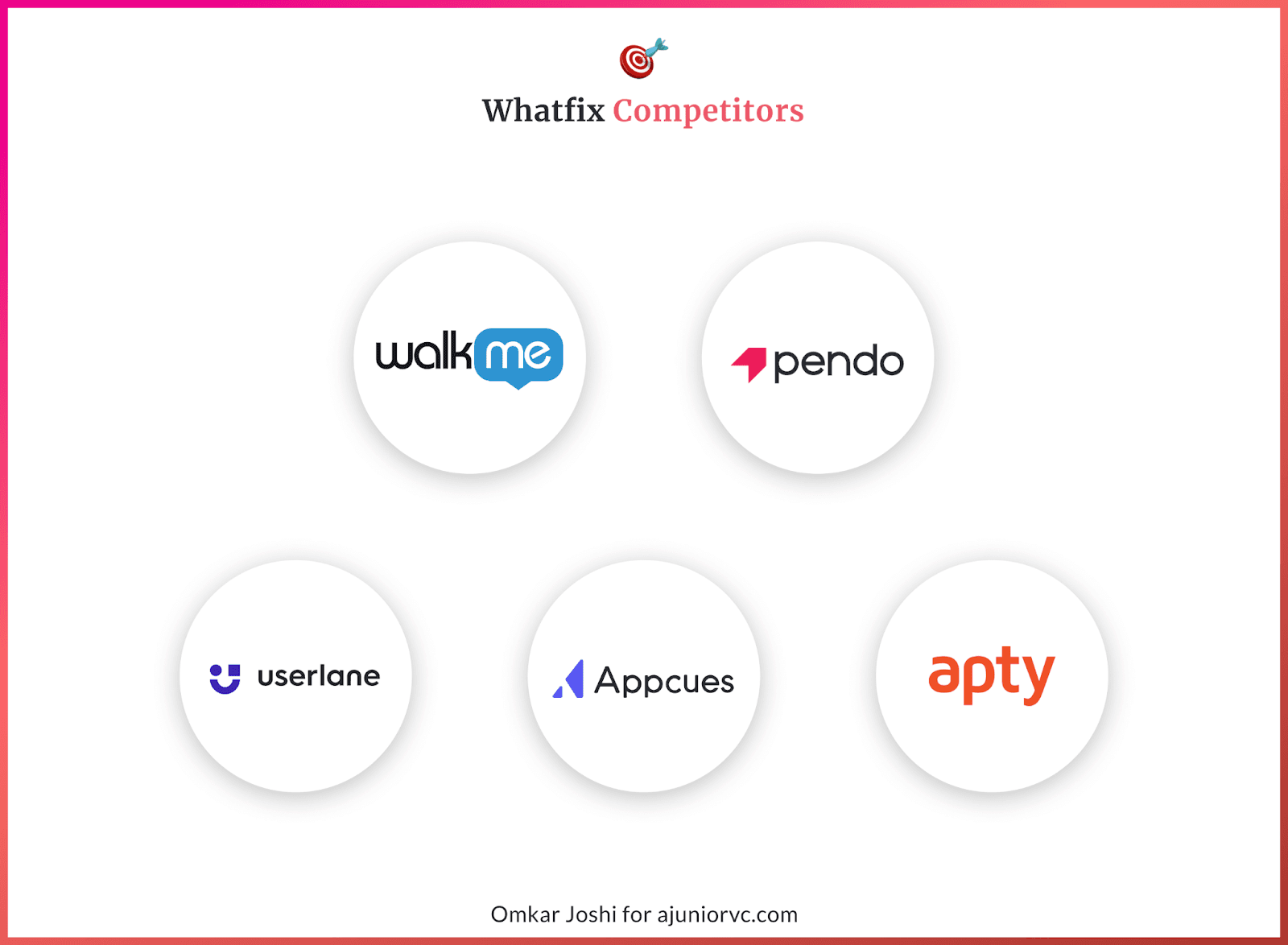
What made Whatfix unique is that they don’t only offer cloud-based interactive guides but also on-premise in-app experiences.
Its flexible pricing was a key strength.
The company wants the customer to pay only for the features opted by them. The pricing depends on several factors, such as the number of users accessing Whatfix content, the base application on which Whatfix is deployed, the mode of deployment, and others.
At the end of 2020, Whatfix acquired Airim, which provides an AI-powered Personalization Engine for users and customers. Airim’s technology was integrated with Whatfix to help bolster its artificial intelligence stack to deliver personalised content to every user autonomously – making Whatfix the industry’s first Digital Adoption Solution (DAS) to offer Autonomous Personalization.
This focus on AI long before it was cool would be prescient.
As the macro trend favours the growth in the topline for Whatfix, to grow the bottom line, Whatfix needed profitable unit economies to run the business at scale
Stairway to Funding Heaven
Whatfix had inherently good margins as it was a software company
Like most other software service providers, Whatfix has three important cost components.
First, salaries and related overheads for the employees who develop the software and manage customers. Next is the hosting and software cost it incurs to deploy and provide its offering. The third is the customer acquisition cost it incurs to market its product.
While the first component, salaries and overheads, is fixed, the software and customer acquisition costs are variable.
Given that the solution is deployed through a browser extension and seems light, we can assume the cost is less than 10%. This cost may be lesser than 5% basis how well-optimised their solution is. For ease of computation, let’s assume it to be 10%.
Assuming this as the software cost, if we look at their filings data, sales & advertisement cost seems to be around 3X the software cost. Considering this relation, we can assume customer acquisition costs to be around 30%.
When we combine this, the overall variable costs will be lesser than 40% which gives Whatfix a contribution margin of 60%. The goal would be to cover fixed costs eventually.
In a growth phase, the marketing cost is usually high. Over time, Whatfix can deliver an 80% margin, as seen in many SaaS businesses.
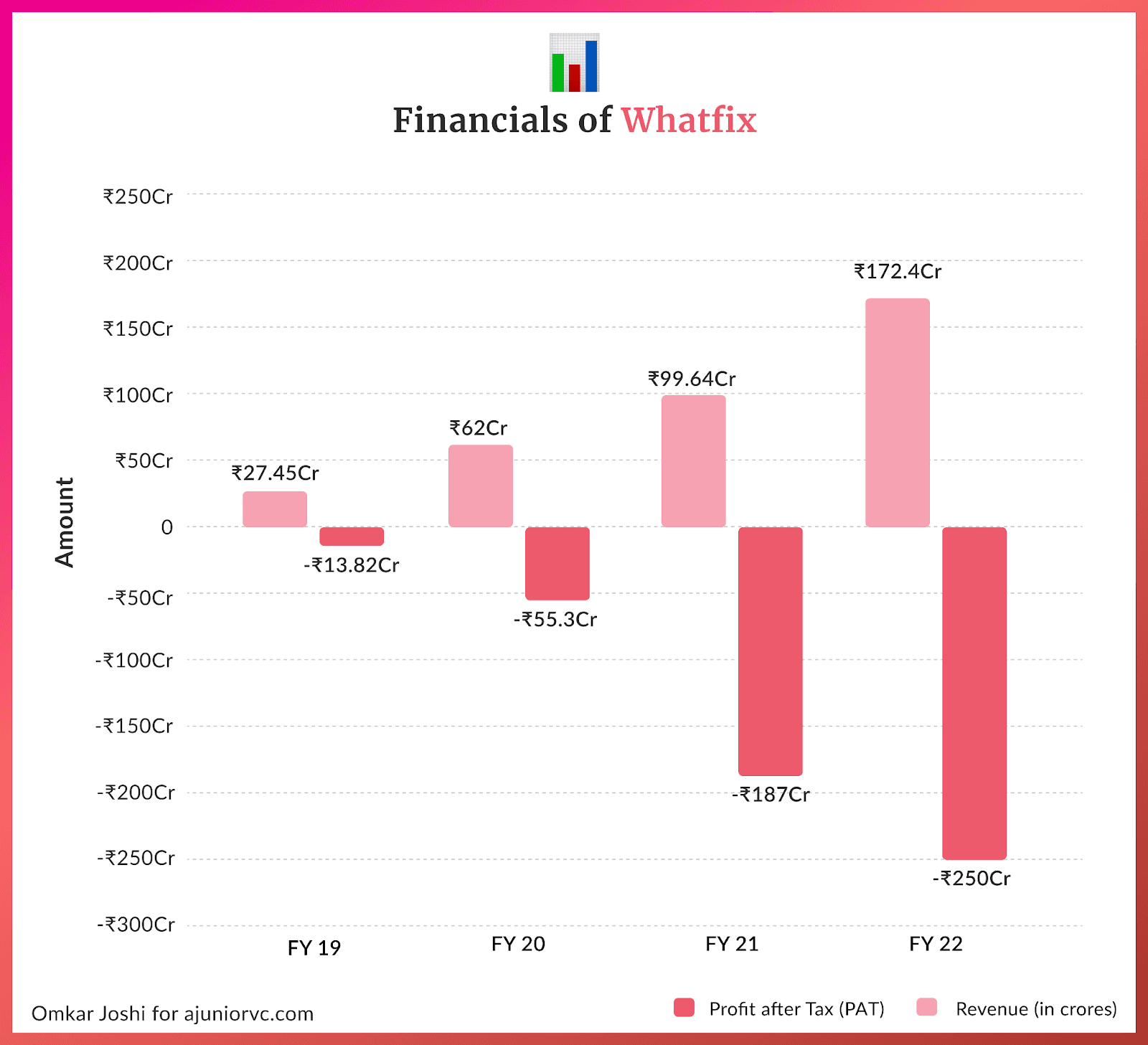
In FY21, it reached the psychological 100 Cr mark, a big win for a company essentially creating a new category.
Investors tend to love these businesses giving a multiple of 10-15x.
And that’s why with a growing topline and healthy margins, Whatfix raised a huge $90 million round in 2021 to fuel the growth engine it has built over the years.
It had incredibly built all of it from India.
Immigrant Software
Starting from India, the company only delivers from India today.
Whatfix gets 73% of its business from the USA; around 20% comes from UK, Germany and France; 5% from Australia; and 2% from India. Interestingly, over 90% of the heavy lifting happens out of India!
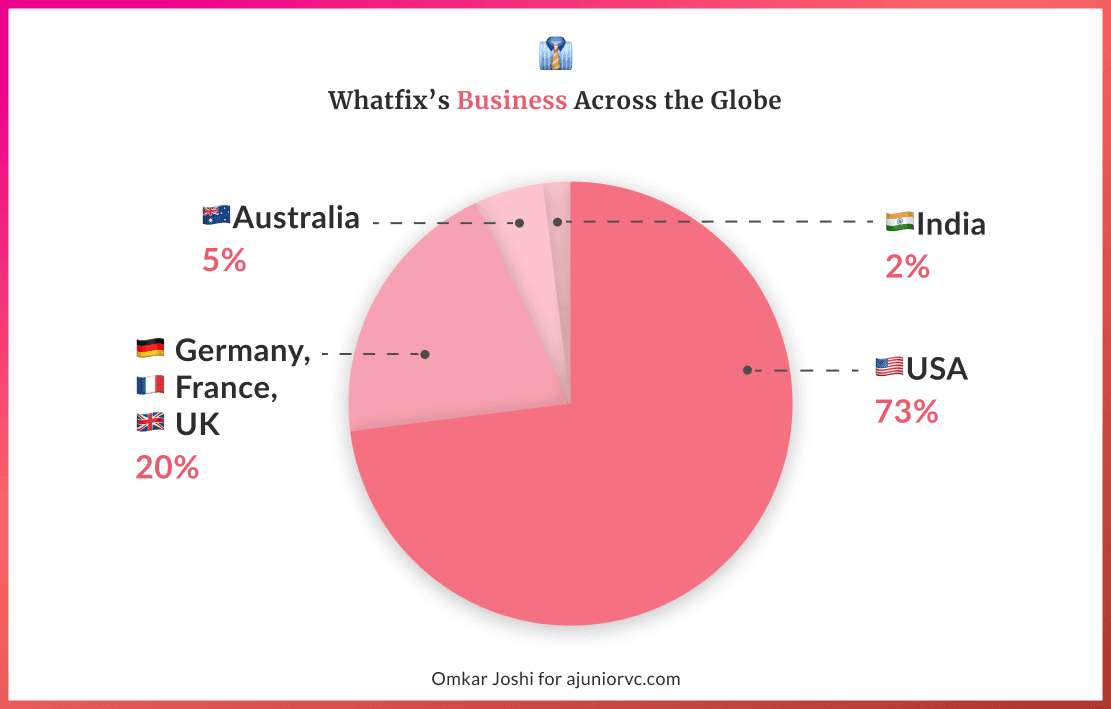
They have 500-plus customers, 150 of which are part of the Fortune 1000. The company has grown to 650 employees across six U.S., U.K., Germany, Australia and India offices.
FY22 was eventful for the B2B digital adoption solutions provider, which raised $90 million, a 4X jump in its valuation in June of 2021.
During the fiscal, the firm managed to grow its income by 73%, but this growth came with a 33% surge in losses. The operating revenue grew 73% to Rs 172 crore in FY22 from Rs 100 crore in FY21, while the losses mounted to Rs 250 crore.
To stay ahead, Whatfix consistently has to add new offerings
Whatfix is fixing the relationship between humans and technology, it takes 37% of employees six months or longer to add value at work. The amount of friction in getting employees up to speed will likely exacerbate the labour and skills shortages companies face.
With their help, companies save costs by saving time, from faster employee onboarding on internal enterprise tech to increased productivity and less error.
While previously, product analytics was built for software vendors, Whatfix extended this capability to software buyers. Since its launch, Product Analytics has grown approximately 200% quarter-on-quarter (QoQ) by revenue and has been adopted by 100+ customers, including large enterprises like Cisco and UPS.
In mid-2022, Whatfix also acquired Leap.is (previously Jiny.io), a mobile-first onboarding and assistance platform that brings the value of digital adoption platforms to mobile applications.
The deal marks its largest M&A deal so far.
In late 2022, it launched Whatfix Studio, a more intuitive and powerful iteration of the current content editor. Studio is built on a low-code platform, enabling content creators to leverage its capabilities with little to no technical skills fully.
Competitors had the edge over Whatfix in product analytics, but in 2023, Whatfix launched its version. It allowed software owners to implement end-to-end analytics for the customer independently- and employee-facing applications, eliminating engineering dependency.
But as the world began to reel from a recession in 2023, SaaS companies needed to buckle up to win. As companies started questioning the need for tools, new solutions were sought.
A storm called AI was coming.
Rock and Roll
With companies spending billions on new software applications, there is still a wide gap, the digital debt gap, between the exponential rise in technology and Human adaptability.
A Fortune 1000 company uses over 150 software applications, and an average employee uses 16 applications once a week. About 45% of these employees experience digital friction.
Global software decision-makers reported that more than 40% of their organisation’s software spending in 2022 went to new software licenses and new custom software solutions.
By 2025, 70% of organisations will use digital adoption platforms across the entire technology stack to overcome still insufficient application user experiences
The opportunity was huge, but the competition threatens
With the growing market and rise of AI, big software providers are exploring the digital adoption problems themselves.
Companies to cut costs are not willing to spend extra on DAPs and want the software application providers to provide better adoption features.
Salesforce launched an AI-powered conversational intelligence platform to its CRM to bridge the adoption gap. With companies like Microsoft announcing a co-pilot for coders, a co-pilot for companies to interact with the software is a natural extension.
Adept, a US-based AI startup, raised an astonishing $450M even before launching a new product to assist people with software. Salesforce and other SaaS tools are building their own AI tools.
Teaching machines to imitate what people do and replicating it is the classical definition of AI.
Whatfix has realised this gap and is working on Independent Software Vendor (ISV) Partnership Programs. Whatfix has established strategic partnerships with software vendors, including SAP, Guidewire, Bullhorn, IBS Software, and Icertis, to help customers accelerate user adoption.
It became one of the only Indian companies to be a leader in a Forrester New Wave platform, being up there with WalkMe and Pendo.
Despite the threat of AI, Whatfix is positioned well due to its almost decade-long experience of understanding how people interact with products. Its acquisition of Airim will goa long way. As the usage of tools continues to increase, a bridge will always be needed between software and humans.
Whatfix could be that lucrative bridge that fixes what breaks in global companies.
Writing: Abhinay, Bhoomika, Rajiv, Ritika, Tanish and Aviral Design: Omkar and Chandra